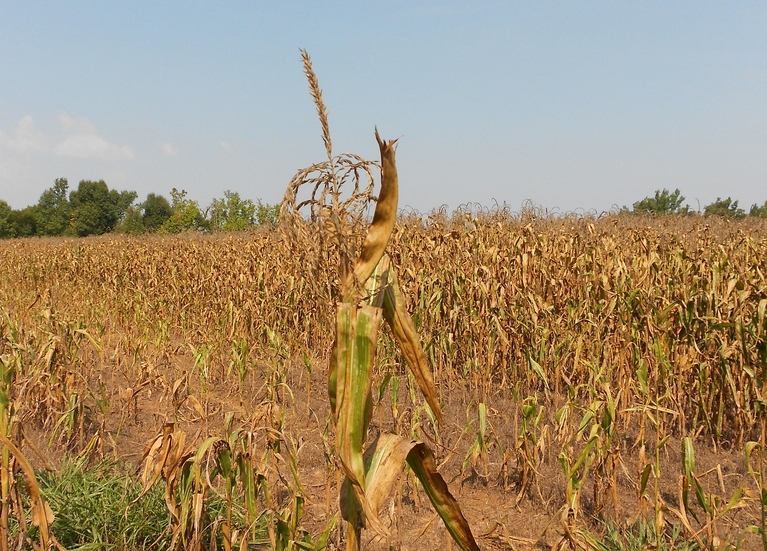Podcast: Play in new window | Download
Subscribe: RSS

Drought-stressed corn, maybe also toxic, bug-bit and weed-plagued, in Kentucky last week. (Photo by CraneStation/Flickr)
The failure of industrial agriculture is on display everywhere in America’s “breadbasket” — now we should probably call it the ethanol basket, or the high-fructose-corn-syrup basket — and the consequences are already spreading around the world. You thought it was just a drought? It would be bad enough of that’s all it was, but it is much, much more. The count so far:
1. The drought. Worse and worser. It has now affected 85 per cent of the corn growing in the United States. Predictions of how much will actually get harvested, and into the pipeline to make high fructose corn syrup or ethanol, have been dropping since mid-summer. As Bloomberg reports, they are about to drop more. Tantalizing rains have fallen here and there, and the blast-furnace temperatures of July have moderated, but stunted plants don’t recover this late in the game.
2. The toxicity. Okay, so the corn doesn’t have much in the way of kernels. It’s still a big, edible plant, right, for animals? As Illinois rancher Steve Foglesong told the Wall Street Journal, “It may not have any ears on it, but it makes pretty good cow feed.” Snag. Thirsty corn plants don’t assimilate synthetic fertilizer well. Their lower leaves tend to accumulate concentrations of nitrates that can kill cows. Reuters reports that panicked feeders are overwhelming testing labs in the Midwest trying to find out if the corn stalks they have left can be used as feed.
3. The Superbugs. Meanwhile, down at the roots of the corn plants, tendrils reaching out desperately in search of water are being cut off by rootworms. This is remarkable, because most of the corn is Monsanto genetically mutilated corn, engineered to be toxic to rootworms. Turned out it was only toxic to some rootworms. The rest are feasting on the (expensive) corn and multiplying happily, especially in Minnesota and Illinois. Turns out the only thing they like better than rootworm-resistant corn is dry weather.
4. The superweeds. Monsanto’s other major gift to industrial agriculture — Roundup and Roundup-Ready crops — continues its transformation into a gift that keeps on taking. The idea is an industrialist’s dream: invent a poison that kills everything, and make a fortune from that, then a plant that is immune to the poison, and make a fortune to the power of 10. Snag again. Roundup resistant weeds, especially pigweed, are flourishing in America’s drought-stunted, worm-eaten crops. Resistant pigweed now infects at least half the cotton fields of the South, according to the Southeast Farm Press.
5. Oh, one more thing. What if an industrial farmer found some water to irrigate his corn in June, say by pumping the last few thousand gallons left in the Ogallala Aquifer, and he found something to kill the rootworms in July, I don’t know, maybe gasoline, and he hired out-of-work mortgage brokers to weed his fields in August, and he actually ends up next month with some corn to sell to Mexico? Where the prices are going to be really good? Snag again. The Mississippi River is so low that, if he can ship it at all, it’s going to be really, really expensive.
On the other hand. Anyone using small acreages to grow personal food or farm-market produce, who uses organic methods, concentrating on soil building and protection (with mulch, for example), using heritage seeds and no chemicals, will survive this drought. And the next one. Even larger acreages where crops are diversified and rotated, and humus is cared for, have a really good chance of making it through (Organic Farms are Weathering the Drought).
And anyone can do it.
See also:
From American Drought to “Global Catastrophe”
Hunger Games in the Heartland
The United States of Monsanto
Monsanto: More Crimes Against Humanity